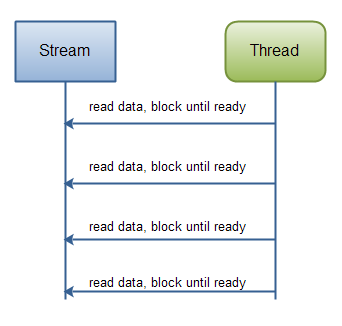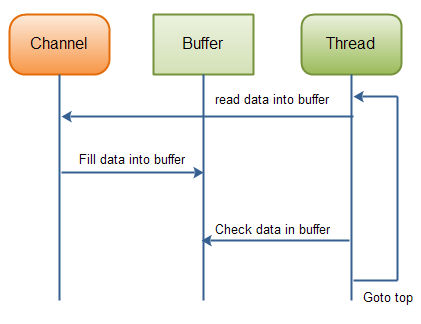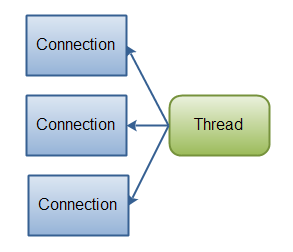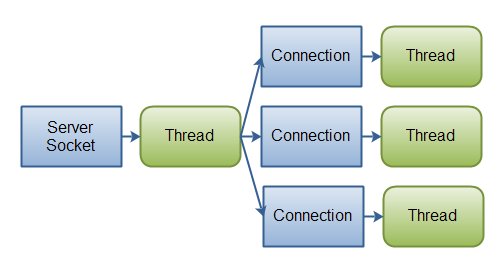Java NIO vs. IO
|
Jakob Jenkov |
When studying both the Java NIO and IO API's, a question quickly pops into mind:
When should I use IO and when should I use NIO?
In this text I will try to shed some light (阐明)on the differences between Java NIO and IO, their use cases, and how they affect the design of your code.
Main Differences Betwen Java NIO and IO
The table below summarizes the main differences between Java NIO and IO. I will get into more detail about each difference in the sections following the table.
| IO | NIO |
| Stream oriented | Buffer oriented |
| Blocking IO | Non blocking IO |
| Selectors |
Stream Oriented vs. Buffer Oriented
面向流和面向buffer
面向流:一次都一些字节,没有缓存,不能前进倒退。如果想这样,需要把他装到一个缓冲里
面向buffer:可以前进后退,更灵活,用之前,需要检查buffer是否含有你需要的的数据,往buffer里写数据的时候也要确保不要覆盖了
The first big difference between Java NIO and IO is that IO is stream oriented, where NIO is buffer oriented. So, what does that mean?
Java IO being stream oriented means that you read one or more bytes at a time, from a stream. What you do with the read bytes is up to you. They are not cached anywhere. Furthermore, you cannot move forth and back in the data in a stream. If you need to move forth and back in the data read from a stream, you will need to cache it in a buffer first.
Java NIO's buffer oriented approach is slightly different. Data is read into a buffer from which it is later processed. You can move forth and back in the buffer as you need to. This gives you a bit more flexibility during processing. However, you also need to check if the buffer contains all the data you need in order to fully process it. And, you need to make sure that when reading more data into the buffer, you do not overwrite data in the buffer you have not yet processed.
Blocking vs. Non-blocking IO
阻塞,非阻塞io, 普通的io当你读数据的时候线程是阻塞的,nio是从Channel中请求数据的,只有可以都读数据的时候才会读,而不是一直阻塞,线程可以做其他事情,没有阻塞时,线程回去其他的Channel做io操作。一个线程管理多个Channel输入输出
Java IO's various streams are blocking. That means, that when a thread invokes a read() or write(), that thread is blocked until there is some data to read, or the data is fully written. The thread can do nothing else in the meantime.
Java NIO's non-blocking mode enables a thread to request reading data from a channel, and only get what is currently available, or nothing at all, if no data is currently available. Rather than remain blocked until data becomes available for reading, the thread can go on with something else.
The same is true for non-blocking writing. A thread can request that some data be written to a channel, but not wait for it to be fully written. The thread can then go on and do something else in the mean time.
What threads spend their idle time on when not blocked in IO calls, is usually performing IO on other channels in the meantime. That is, a single thread can now manage multiple channels of input and output.
Selectors
一个selector管理多个thread
Java NIO's selectors allow a single thread to monitor multiple channels of input. You can register multiple channels with a selector, then use a single thread to "select" the channels that have input available for processing, or select the channels that are ready for writing. This selector mechanism makes it easy for a single thread to manage multiple channels.
How NIO and IO Influences Application Design
Whether you choose NIO or IO as your IO toolkit may impact the following aspects of your application design:
- The API calls to the NIO or IO classes.
- The processing of data.
- The number of thread used to process the data.
The API Calls
函数调用不一样
Of course the API calls when using NIO look different than when using IO. This is no surprise. Rather than just read the data byte for byte from e.g. an InputStream, the data must first be read into a buffer, and then be processed from there.
The Processing of Data
处理数据不一样
The processing of the data is also affected when using a pure NIO design, vs. an IO design.
In an IO design you read the data byte for byte from an InputStream or a Reader. Imagine you were processing a stream of line based textual data. For instance:
Name: Anna Age: 25 Email: anna@mailserver.com Phone: 1234567890
This stream of text lines could be processed like this:
InputStream input = ... ; // get the InputStream from the client socket BufferedReader reader = new BufferedReader(new InputStreamReader(input)); String nameLine = reader.readLine(); String ageLine = reader.readLine(); String emailLine = reader.readLine(); String phoneLine = reader.readLine();
一次读一行,读完了一行线程阻塞到处理完这一行,再读下一行
Notice how the processing state is determined by how far the program has executed. In other words, once the first reader.readLine() method returns, you know for sure that a full line of text has been read. The readLine() blocks until a full line is read, that's why. You also know that this line contains the name. Similarly, when the second readLine() call returns, you know that this line contains the age etc.
As you can see, the program progresses only when there is new data to read, and for each step you know what that data is. Once the executing thread have progressed past reading a certain piece of data in the code, the thread is not going backwards in the data (mostly not). This principle is also illustrated in this diagram:
 |
| Java IO: Reading data from a blocking stream. |
A NIO implementation would look different. Here is a simplified example:
ByteBuffer buffer = ByteBuffer.allocate(48); int bytesRead = inChannel.read(buffer);
buffer中有一些字节,但是不一定是所有的字节都在里面,那你咋知道到底有没有所有的数据呢?你需要多次检查这个数据,不是很高效,有点混乱
Notice the second line which reads bytes from the channel into the ByteBuffer. When that method call returns you don't know if all the data you need is inside the buffer. All you know is that the buffer contains some bytes. This makes processing somewhat harder.
Imagine if, after the first read(buffer) call, that all what was read into the buffer was half a line. For instance, "Name: An". Can you process that data? Not really. You need to wait until at leas a full line of data has been into the buffer, before it makes sense to process any of the data at all.
So how do you know if the buffer contains enough data for it to make sense to be processed? Well, you don't. The only way to find out, is to look at the data in the buffer. The result is, that you may have to inspect the data in the buffer several times before you know if all the data is inthere. This is both inefficient, and can become messy in terms of program design. For instance:
ByteBuffer buffer = ByteBuffer.allocate(48);
int bytesRead = inChannel.read(buffer);
while(! bufferFull(bytesRead) ) {
bytesRead = inChannel.read(buffer);
}
bufferFull检查buffer是不是满了
The bufferFull() method has to keep track of how much data is read into the buffer, and return either trueor false, depending on whether the buffer is full. In other words, if the buffer is ready for processing, it is considered full.
The bufferFull() method scans through the buffer, but must leave the buffer in the same state as before the bufferFull() method was called. If not, the next data read into the buffer might not be read in at the correct location. This is not impossible, but it is yet another issue to watch out for.
If the buffer is full, it can be processed. If it is not full, you might be able to partially process whatever data is there, if that makes sense in your particular case. In many cases it doesn't.
The is-data-in-buffer-ready loop is illustrated in this diagram:
 |
| Java NIO: Reading data from a channel until all needed data is in buffer. |
Summary
nio 可以让你用Channel管控多个thread,代价是会复杂一点;如果你要同时管理上千的连接,每个连接只有一点数据,如聊天服务,用NIO比较好;和其他电脑保持大量连接的话,用NIO也是比较好的
NIO allows you to manage multiple channels (network connections or files) using only a single (or few) threads, but the cost is that parsing the data might be somewhat more complicated than when reading data from a blocking stream.
If you need to manage thousands of open connections simultanously, which each only send a little data, for instance a chat server, implementing the server in NIO is probably an advantage. Similarly, if you need to keep a lot of open connections to other computers, e.g. in a P2P network, using a single thread to manage all of your outbound connections might be an advantage. This one thread, multiple connections design is illustrated in this diagram:
 |
| Java NIO: A single thread managing multiple connections. |
If you have fewer connections with very high bandwidth, sending a lot of data at a time, perhaps a classic IO server implementation might be the best fit. This diagram illustrates a classic IO server design:
如果你有比较少的连接,和非常高的宽带,一次要送大量的数据,也许一个普通的IO会比较好
 |
| Java IO: A classic IO server design - one connection handled by one thread. |